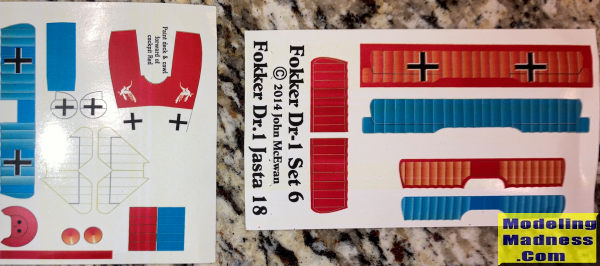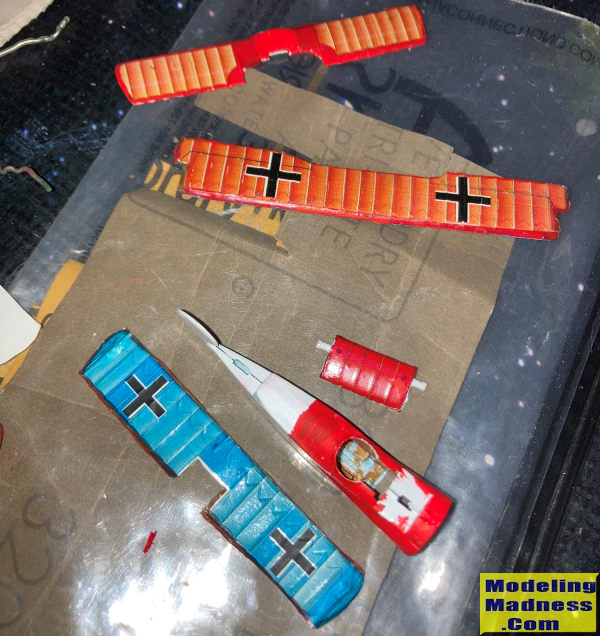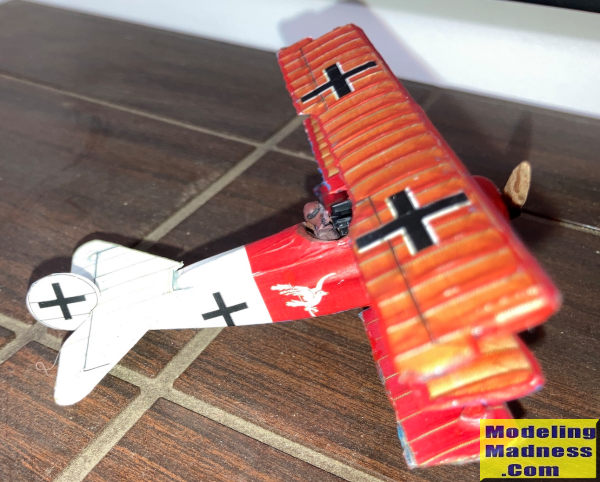I've long been entranced by the colorful paint-schemes that many aircraft wore in the Great War, and a visit to the Military Aviation Museum south of Virginia Beach, VA got me ready to attempt a few biplane kits in my favored scale.
Having cheaply scored a D-VII and DR-1 from the old Revell molds of the 1960s, both of them relatively easy kits for the novice biplane-builder, I decided that I wanted a lozenge scheme. Nothing shouts "Knights of the Air!" quite so loudly.
I'd mentioned the Germans' strange-looking paint jobs to a friend who is not a modeler, but who has spent years in search-and-rescue. Part of his training involved studying the history of camouflage. As he told me, the trick to any camo scheme involves not so much hiding an object completely but making the eye lose a target's outline. The Germans had become expert at that sort of paint scheme. With the eye constantly refocusing, how could an enemy easily shoot at something? Then consider the problem of two aircraft, each moving at more than 100 mph.
My research was scanty on the effectiveness of lozenge camo, but that will be something for a rainy day. Now imagine painting that scheme in 1/72, then catch your breath if you can find it. So I looked for an alternative.

| THE DECALS |
I found Reviresco though a quick Google search and ordered sets from a company called Tin Soldier. Reviresco specializes in 1/144 subjects for war-gaming but also makes a number of decals in that tiny scale, as well as 1/72. I ordered the Jasta 18 set, a red-and-white aircraft, as well as a set depicting the yellow D-VII of Oblt. Erich Lowenhardt.
My decals arrived printed beautifully on a single sheet of clear carrier film. They include very detailed instructions on preparing the surface. Many areas will need to be painted white, and for the DR-1, the manufacturer recommended red for the cowling and front section of the fuselage. Some old Armory Blood Red acrylic, brushed on, proved an excellent match.
 Each decal needs to be cut out carefully, and
some of the larger sections benefit from being cut into multiple pieces. I
worked on one part of the aircraft at a time, after the fuselage was
together; one must (of course) put the wing decals on before attaching them
to the rest of the Fokker!
Each decal needs to be cut out carefully, and
some of the larger sections benefit from being cut into multiple pieces. I
worked on one part of the aircraft at a time, after the fuselage was
together; one must (of course) put the wing decals on before attaching them
to the rest of the Fokker!
While each decal soaked, I put down a thinned coat of white school glue, working quickly since Reviresco recommends 20 seconds in warm water. They also advise trimming big, then wrapping the ends around on the other side of the wing.
That was my one mistake. I let the ends flap, which meant lots of trimming and touch-up painting later. Be sure you wrap the decals and let them dry, following the instructions with care. After the tops of the wings are done, a builder can always paint over the wrapped parts on the bottom. No seams should show when this is done, as the film is thin, yet tough. One warning: the colors will come off with light handling, after they dry. I learned to coat the finished parts with Tamiya flat clear.
I did quite a bit of touch-up painting on both kits, including a few lozenges that lost their paint, because I did not follow that one rule. Mixing just the right colors for that job was "interesting," but a good bit of painterly practice I rather enjoyed, as I got to say the word "mauve" a lot. The end result proved quite pleasing, especially how the decals have shading for the ribbing on the aircraft wings.
I decided to paint the D-VII fuselage, but the DR-1 had some nice fuselage insignia so I used the decals there, too. It wrinkled in one spot, but it's hard to see in this scale and all my fault.
Another bit of advice: The triplane's midwing decals are markedly too small for the old-tool Revell kit. They might fit later issues of the 1/72 Fokker by Revell and other firms. I was in luck here, as the wing in question was solid red on top and blue below. Out came the brushes.
| CONCLUSIONS |
 I recommend these decals for any modeler
patient enough to follow directions well. If you are otherwise put off by
trying to duplicate the intricate paint-schemes of the Kaiser's pilots,
here's your chance. It was better than painting in many regards, mainly
because I did not have to go to my shop where the airbrush lives.
I recommend these decals for any modeler
patient enough to follow directions well. If you are otherwise put off by
trying to duplicate the intricate paint-schemes of the Kaiser's pilots,
here's your chance. It was better than painting in many regards, mainly
because I did not have to go to my shop where the airbrush lives.
Reviresco makes a nice line of German decals in some amazing colors. I wish they had more 1/72 Central Powers and Allied planes, beyond several sets for the Spad XIII. Having acquired via eBay a brace of Revell Sopwith Camels crammed into one ancient box, I'm ready for my next dawn patrol. Back to the airbrush, Biggles!